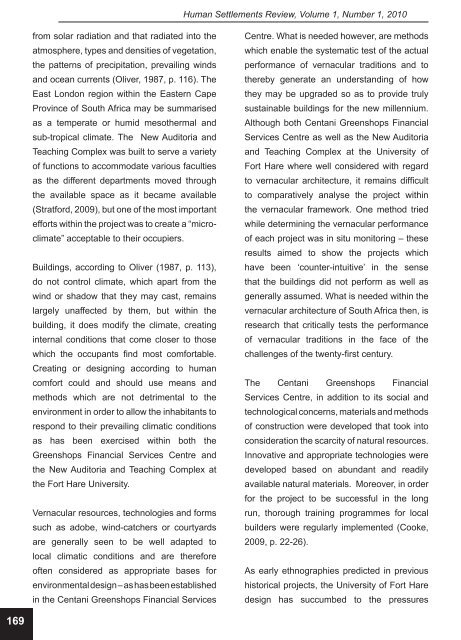Human Settlements Review - Parliamentary Monitoring Group
Human Settlements Review - Parliamentary Monitoring Group
Human Settlements Review - Parliamentary Monitoring Group
You also want an ePaper? Increase the reach of your titles
YUMPU automatically turns print PDFs into web optimized ePapers that Google loves.
<strong>Human</strong> <strong>Settlements</strong> <strong>Review</strong>, Volume 1, Number 1, 2010<br />
from solar radiation and that radiated into the<br />
atmosphere, types and densities of vegetation,<br />
the patterns of precipitation, prevailing winds<br />
and ocean currents (Oliver, 1987, p. 116). The<br />
East London region within the Eastern Cape<br />
Province of South Africa may be summarised<br />
as a temperate or humid mesothermal and<br />
sub-tropical climate. The New Auditoria and<br />
Teaching Complex was built to serve a variety<br />
of functions to accommodate various faculties<br />
as the different departments moved through<br />
the available space as it became available<br />
(Stratford, 2009), but one of the most important<br />
efforts within the project was to create a “microclimate”<br />
acceptable to their occupiers.<br />
Buildings, according to Oliver (1987, p. 113),<br />
do not control climate, which apart from the<br />
wind or shadow that they may cast, remains<br />
largely unaffected by them, but within the<br />
building, it does modify the climate, creating<br />
internal conditions that come closer to those<br />
which the occupants find most comfortable.<br />
Creating or designing according to human<br />
comfort could and should use means and<br />
methods which are not detrimental to the<br />
environment in order to allow the inhabitants to<br />
respond to their prevailing climatic conditions<br />
as has been exercised within both the<br />
Greenshops Financial Services Centre and<br />
the New Auditoria and Teaching Complex at<br />
the Fort Hare University.<br />
Vernacular resources, technologies and forms<br />
such as adobe, wind-catchers or courtyards<br />
are generally seen to be well adapted to<br />
local climatic conditions and are therefore<br />
often considered as appropriate bases for<br />
environmental design – as has been established<br />
in the Centani Greenshops Financial Services<br />
Centre. What is needed however, are methods<br />
which enable the systematic test of the actual<br />
performance of vernacular traditions and to<br />
thereby generate an understanding of how<br />
they may be upgraded so as to provide truly<br />
sustainable buildings for the new millennium.<br />
Although both Centani Greenshops Financial<br />
Services Centre as well as the New Auditoria<br />
and Teaching Complex at the University of<br />
Fort Hare where well considered with regard<br />
to vernacular architecture, it remains difficult<br />
to comparatively analyse the project within<br />
the vernacular framework. One method tried<br />
while determining the vernacular performance<br />
of each project was in situ monitoring – these<br />
results aimed to show the projects which<br />
have been ‘counter-intuitive’ in the sense<br />
that the buildings did not perform as well as<br />
generally assumed. What is needed within the<br />
vernacular architecture of South Africa then, is<br />
research that critically tests the performance<br />
of vernacular traditions in the face of the<br />
challenges of the twenty-first century.<br />
The Centani Greenshops Financial<br />
Services Centre, in addition to its social and<br />
technological concerns, materials and methods<br />
of construction were developed that took into<br />
consideration the scarcity of natural resources.<br />
Innovative and appropriate technologies were<br />
developed based on abundant and readily<br />
available natural materials. Moreover, in order<br />
for the project to be successful in the long<br />
run, thorough training programmes for local<br />
builders were regularly implemented (Cooke,<br />
2009, p. 22-26).<br />
As early ethnographies predicted in previous<br />
historical projects, the University of Fort Hare<br />
design has succumbed to the pressures<br />
169









![National Research Foundation Annual Report 2008 / 2009 [Part 2]](https://img.yumpu.com/49774036/1/177x260/national-research-foundation-annual-report-2008-2009-part-2.jpg?quality=85)







